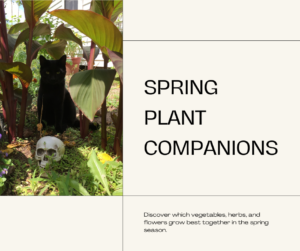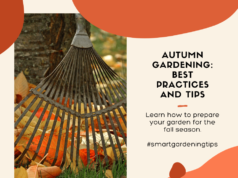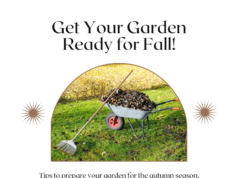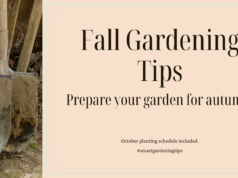
Spring is the perfect time to start planning your vegetable, herb, and flower garden. But did you know that certain plants can make elegant companions, enhancing growth, repelling pests, and creating a beautiful combination of colors and textures?
Companion planting is the art of selecting plants that thrive when grown together. By choosing the right companions for your spring garden, you can enjoy a bountiful harvest and an aesthetically pleasing landscape. In this article, we will explore the benefits and factors to consider for successful companion planting, as well as specific plant combinations for common vegetables, herbs, and flowers.
Key Takeaways:
- Companion planting can promote optimal growth, natural pest control, and create an elegant combination of plants.
- Choosing the right companions for your spring garden is essential for success.
- Factors such as soil requirements, spacing, and compatibility should be considered before selecting plant combinations.
- Specific combinations of vegetables, herbs, and flowers can enhance growth and flavor and attract beneficial insects.
- Proper techniques such as timing and spacing are important for successful companion planting.
Benefits of Companion Planting
Are you looking for natural ways to control pests and improve the flavor of your spring garden? Companion planting may be the solution you need. Planting compatible plants together offers a host of benefits, including:
- Natural pest control: Certain plant combinations repel pests, reducing the need for harmful chemicals.
- Improved flavor: Some companions enhance the flavor of neighboring plants, making your vegetables and herbs even more delicious.
- Optimized nutrient uptake: Certain plants have complementary nutrient requirements, allowing them to thrive together and absorb nutrients more efficiently.
In addition to these benefits, companion planting can also improve plant growth and help prevent disease. For example, planting marigolds with tomatoes can deter pests and promote growth.
Why not try companion planting in your spring garden and enjoy the benefits? Take a look at our table below for some ideas on which plants make great companions.
Table 1: Sample Vegetable Companions
| Vegetable | Complementary Vegetables | Incompatible Vegetables |
|---|---|---|
| Tomatoes | Carrots, Basil, Marigold | Potatoes, Fennel, Cabbage |
| Peppers | Basil, Carrots, Onions, Marigold | Fennel, Beans, Brassicas |
| Cucumbers | Beans, Radish, Marigold | Potatoes, Aromatic Herbs |
As you can see from the sample table, planting the right vegetables together can promote growth and prevent problems. Take time to research companion planting techniques for your favorite vegetables, herbs, and flowers, and experiment with different combinations to create an elegant and productive spring garden.
Factors to Consider for Successful Companion Planting
Companion planting can provide numerous benefits to your spring garden by enhancing growth and pest control. However, to ensure successful plant companions, it’s crucial to consider several important factors.
- Soil requirements: Different plants have different soil preferences, and planting them together can affect the quality of the soil. For instance, nitrogen-loving plants could enhance the growth of other vegetables by fixing nitrogen in the soil.
- Spacing: Plants require adequate spacing to grow to their full potential. Companion plants with similar height and foliage can be planted together, while tall and bushy plants should be separated from low-growing ones.
- Watering and fertilization: Companion plants have different water and nutrient requirements. Choosing plants that have similar watering and fertilization needs can promote their successful growth.
- Seasonal compatibility: Plants have different growing seasons, which should be considered when planting companions. For instance, cool-season vegetables, such as broccoli, can thrive with other cool-season plants such as lettuce and kale.
- Pest control: Companion planting can repel pests naturally by using plants that release scents that deter harmful insects. Plants such as marigolds can repel nematodes in tomatoes.
Soil Preferences for Popular Vegetables
| Vegetables | Preferred Soil pH | Soil Type | Soil Nutrient Preferences |
|---|---|---|---|
| Tomatoes | 6.0-7.0 | Sandy, Loamy | High Nitrogen, High Phosphorus, Calcium, Potassium |
| Carrots | 5.8-7.0 | Sandy | High Potassium, Phosphorus, Calcium, Magnesium |
| Lettuce | 6.0-7.0 | Loamy, Sandy Loam | High Nitrogen, Potassium, Calcium, Iron |
| Broccoli | 6.0-7.0 | Sandy Loam | High Magnesium, Calcium, Potassium, Phosphorus |
By considering the factors above, you can create elegant plant companions that promote optimal growth and pest control in your spring garden. In the next section, we will discuss vegetable companions that complement each other and those that should be kept apart to avoid compatibility issues.
Vegetable Companions for Better Growth and Pest Control
Companion planting is an effective way to boost the growth of your vegetable plants and control pests naturally. Certain vegetables thrive when planted together, forming a symbiotic relationship that promotes each other’s growth. On the other hand, some vegetables may be incompatible, affecting each other’s development negatively.
The key to successful vegetable companionship is to plant complementary vegetables for better growth and pest control.
For example, planting basil alongside tomatoes is an effective way to repel pests such as aphids and spider mites, while also enhancing the flavor of your tomatoes. Similarly, planting marigolds with broccoli helps to ward off cabbage worms and root maggots, improving the overall health of your broccoli plants.
On the other hand, there are some incompatible vegetable combinations that you should avoid planting together. For instance, planting onions and beans near each other may result in stunted growth and diminished yields.
Check out the table below for some examples of vegetable companions and incompatible combinations:
| Vegetable Companions | Incompatible Vegetables |
|---|---|
| Tomatoes + basil | Tomatoes + fennel |
| Broccoli + marigolds | Broccoli + strawberries |
| Carrots + onions | Carrots + dill |
Remember, planting complementary vegetables together is a natural way to promote the growth and health of your garden. An elegant combination of vegetable companions creates a healthy and thriving ecosystem in your spring garden.
Herb Companions for Pest Repellent and Enhanced Flavor
Herbs not only add flavor to your meals but also offer a natural and effective way to repel pests and promote growth in your garden. By planting compatible herbs together, you can create a stronger defense against unwanted insects and enhance the flavor of nearby vegetables and fruits.
Some of the best herb companions include:
| Herbs that Repel Pests | Herbs that Enhance Flavor | Herbs that Should be Kept Separate |
|---|---|---|
| Chives | Basil | Mint |
| Lavender | Parsley | Dill |
| Rosemary | Thyme | Coriander/Cilantro |
| Sage | Marjoram |
Note: The above list is not comprehensive and may vary based on your region and climate.
Planting herbs together can provide numerous benefits, but it’s important to keep in mind their different growth patterns and needs. Some herbs may require more water or sunlight than others, while some may have invasive tendencies. To ensure optimal growth, keep incompatible herbs separate and consider companion planting with other compatible herbs and vegetables.
Flower Companions for Beneficial Insects and Pest Deterrence
Incorporating flowers in your spring garden doesn’t only enhance its beauty, but it can also attract beneficial insects that can help keep pests at bay. However, it’s essential to be mindful of the flowers you choose as some can compete with vegetables for resources or hinder their growth. Here are some flower companions that can help deter pests and improve the overall health of your garden:
| Flower Companions | Benefits | Competition or Hindrance |
|---|---|---|
| Marigolds | Attracts beneficial insects, deters pests such as nematodes and whiteflies, improves the taste of neighboring vegetables | Avoid growing with beans or cabbage as it may stunt their growth |
| Nasturtiums | Attracts beneficial insects, edible leaves and flowers, deters pests such as aphids and whiteflies | Avoid growing with brassicas as they may attract caterpillars that feed on both nasturtiums and brassicas |
| Lavender | Attracts beneficial insects, enhances the flavor of neighboring vegetables | Avoid growing with parsley as it may stunt its growth |
Experiment with different flower companions in your garden and observe how they interact with your vegetables and herbs. With a little planning, you can create a beautiful and functional garden that attracts beneficial insects and deters pests.
Specific Plant Combinations for Common Vegetables, Herbs, and Flowers
Companion planting can be both aesthetically pleasing and beneficial for your spring garden. Here are some specific plant combinations that work well together:
Vegetable Companions
When it comes to companion planting with vegetables, some combinations are more successful than others. Here are some of the best plant companions for common vegetables:
| Vegetable | Companion plants |
|---|---|
| Tomatoes | Basil, parsley, marigold, borage |
| Lettuce | Carrots, radishes, strawberries |
| Peppers | Basil, parsley, marigold, borage |
| Beans | Carrots, beets, cucumbers, corn |
However, some combinations should be avoided as they can hinder each other’s growth. For example, beans and onions should not be planted together as their growth can be stunted.
Herb Companions
Herbs can also make elegant companions in your garden and can help repel pests while enhancing the flavor of your vegetables. Here are some successful herb companions:
- Basil and tomatoes
- Chives and carrots
- Dill and cucumbers
- Mint and cabbage
However, not all herbs make good companions, and some should be kept separate due to different growth patterns or specific needs. For example, sage does not thrive near basil or cucumbers.
Flower Companions
Flowers are not only beautiful, but they can attract beneficial insects and deter pests in your garden. Here are some flower companions that work well with other plants:
- Marigolds and tomatoes
- Zinnias and beans
- Nasturtiums and cucumbers or squash
- Calendula and lettuce or cabbage
However, some flowers may compete for resources or hinder vegetable growth. For example, sunflowers and pole beans should not be planted together as they both require a lot of space to grow.
By using these specific plant combinations, you can create an elegant and harmonious spring garden with the best plant companions for common vegetables, herbs, and flowers.
Tips for Successful Spring Plant Companions
Companion planting can be a rewarding experience, but it requires proper planning and care to achieve success. Here are some valuable tips and techniques to help maximize the benefits of your elegant plant companions:
1. Know your plants
Before you begin pairing plants together, ensure that you are familiar with their growth habits, soil requirements, and potential interactions with other plant species. Researching your chosen plants beforehand can help avoid common pitfalls and ensure optimal growth.
2. Plan your garden layout
Sketch out your garden layout ahead of time, taking into account the recommended spacing for each plant, and factoring in the amount of sunlight and shade in each area of your garden. This will help you optimize your space and avoid overcrowding, which can stunt plant growth and increase the risk of disease.
3. Consider timing
Timing is key to successful companion planting. Planting times may vary depending on the crop and the climate in your region, but it’s important to ensure that plants are at the same stage of growth to maximize their mutually beneficial interactions. For example, planting herbs around the base of tomato plants can repel pests and improve flavor, but the herbs should be planted at the same time as the tomatoes to ensure optimal results.
4. Incorporate diversity
Diversity is important in companion planting, as it can help enhance soil fertility and ward off pests and diseases. Consider adding a variety of flowers, herbs, and vegetables to your garden to promote a healthy and sustainable ecosystem.
5. Rotate your crops
Rotating your crops from year to year can help prevent soil-borne diseases and pests from building up in your garden. Consider adding cover crops in between growing seasons to help build soil health and reduce erosion.
6. Monitor plant growth
Regularly monitoring your plants for signs of disease or stress can help you catch problems early on and take swift action. Consider using natural pest control methods, such as companion planting and beneficial insects, before resorting to chemical pesticides, which can harm the environment and other beneficial insects.
By following these tips and putting in the effort to plan and care for your elegant plant companions, you can create a vibrant and thriving spring garden.
FAQ
Q. What are the benefits of companion planting?
A. Companion planting offers numerous benefits for your spring garden. It can provide natural pest control, improved flavor, and enhanced growth for your plants.
Q. What factors should I consider for successful companion planting?
A. Before diving into specific plant combinations, it’s important to consider factors such as soil requirements, spacing, and plant compatibility to ensure successful companion planting.
Q. Which vegetables can be grown together for better growth and pest control?
A. Certain vegetables thrive when grown together as companions, promoting better growth and natural pest control. It is crucial to choose complementary vegetables and avoid incompatible combinations to achieve optimal results.
Q. What are some herbs that can be grown together to repel pests and enhance flavor?
A. When it comes to herb companions, there are certain herbs that can repel pests and enhance the flavor of neighboring plants. However, it is important to keep separate herbs with different growth patterns or specific needs.
Q. Which flowers make good companions for vegetables, herbs, and each other?
A. Flowers can be valuable companions in the garden, attracting beneficial insects and deterring pests. However, it is essential to choose flowers that complement each other and do not compete for resources or hinder vegetable growth.
Q. Can you suggest specific plant combinations for common vegetables, herbs, and flowers?
A. Absolutely! We have compiled a list of specific plant combinations that work well together in the spring garden. These combinations include the best plant companions for common vegetables, herbs, and flowers, as well as combinations to avoid due to compatibility issues.
Q. What are some tips for successful spring plant companions?
A. To ensure successful companion planting in your spring garden, we have prepared valuable tips and techniques for you. These tips cover important aspects such as proper spacing, timing, and maximizing the benefits of elegant plant companions.
Conclusion
Congratulations on learning about the elegant companions of spring plants! By incorporating companion planting techniques in your garden, you can create a visually appealing and productive space.
Remember to consider the benefits of companion planting, including natural pest control and enhanced flavor. Keep in mind the factors that contribute to successful companion planting, such as soil requirements and spacing.
Experiment with specific plant combinations for common vegetables, herbs, and flowers, and avoid problematic combinations that may hinder growth or create compatibility issues.
Finally, make sure to follow tips for successful spring plant companions, including proper timing and spacing. With the right approach, you can enjoy the benefits of a beautiful and bountiful spring garden with elegant plant companions.
















